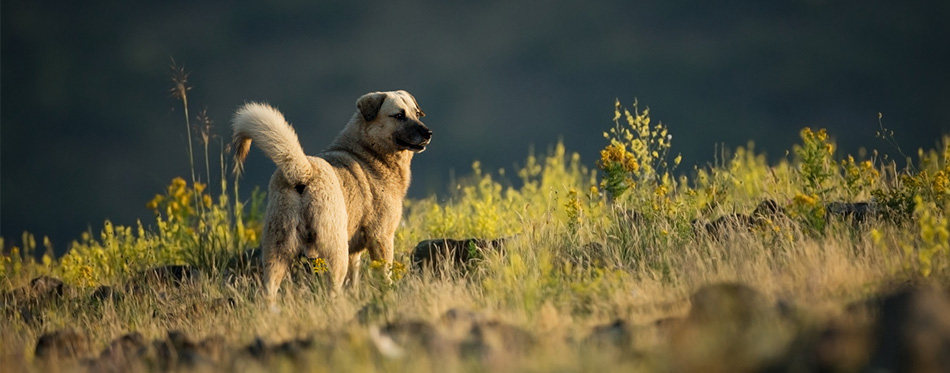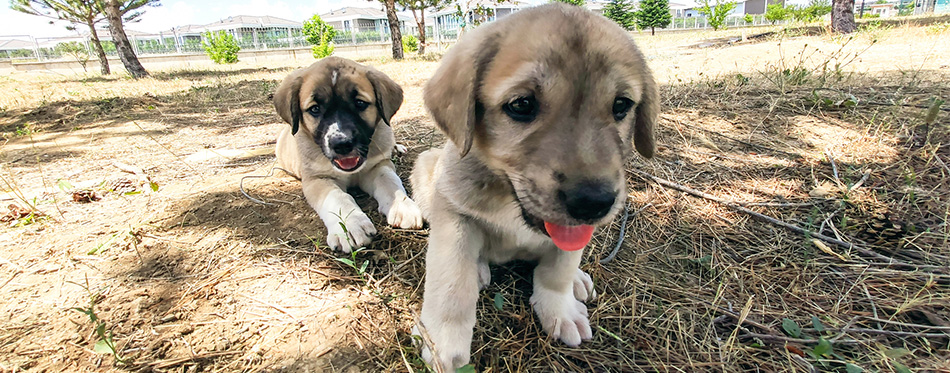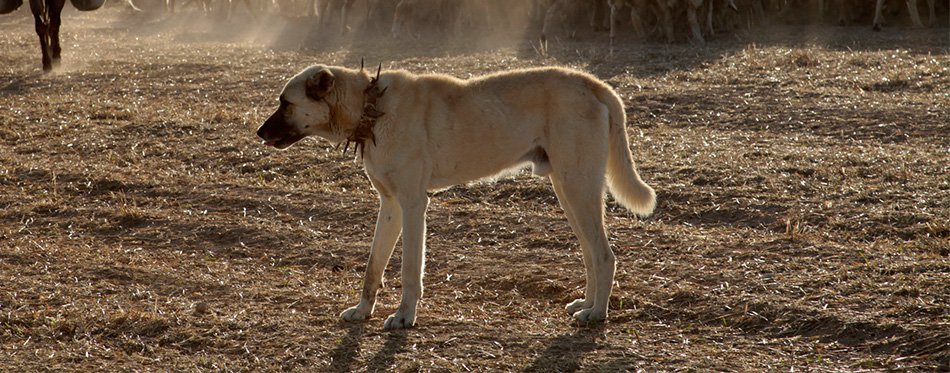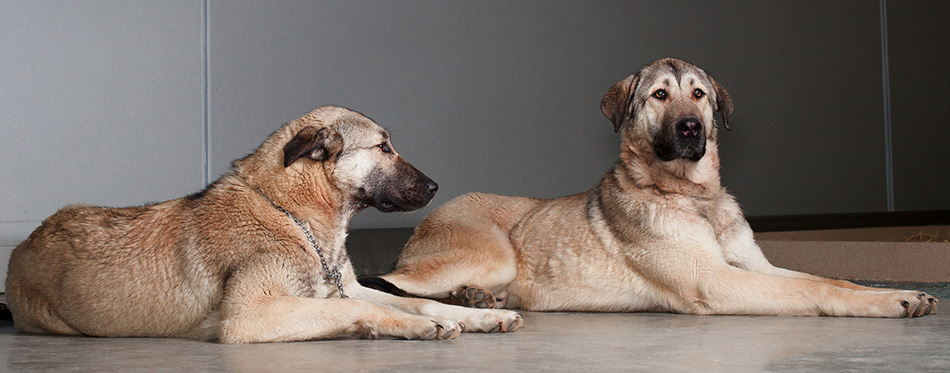Reserved, independent, and loyal. These are the three words that best describe the Kangal Dog. It is a rugged and imposing guardian of Turkish livestock that will protect its owners and their prized possessions. It is a muscular avenger, known for its remarkable work ethic. While it is fiercely loyal and patient, this is a breed that only seasoned dog owners dare have in their homes.

History of the Kangal Dog
There is very little that is known about the origins of the Kangal dog. The reason for this is that the dog is a livestock guardian that Turkey kept to itself. It was only in the middle of the 20th century when the very first Kangal dogs were able to go international, first reaching American shores in the 1950s. They reached the British Isles in the 60s but it was only in the 70s when they started gaining recognition.
Records from the Turkish Kennel Club, the Ankara Kangal Association, and the Cynology Federation of Turkey show that the breed is a descendant of very powerful Mesopotamian hunting dogs. If the records are accurate, this puts the Kangal as a very old breed, as old as 6,000 years.
The descendants of the Kangal are excellent hunters. They faced ferocious beasts such as cheetahs, tigers, wolves, and bears. Their sheer strength and raw courage allowed them to face such threats with confidence. The same characteristic made them very formidable defenders of the livestock of Turkish farmers and herders.
The breed owes its name to one of Turkey’s Central Anatolian towns named “Kangal”. Because this town is also located in Anatolia, the Kangal is often mistaken as the Anatolian Shepherd. Outside Turkey, these are two different breeds. In its native land, however, they belong to the same breed.
It was in 1967 when the very first Kangals was successfully bred outside Turkey. The parents of the litter included Gazi and Sabahat from the villages of Bakirtollo and Hayiroglu, respectively. The litter became the foundation for the breeding of the Kangal in Britain, forming the Seacop stock.
In the US, the breeding of the Kangal was slow, although there have already been dogs imported from Turkey in the 1950s. The US breeding program began in earnest in the 1980s.
In 2012, the Australian National Kennel Council recognized the Kangal as being the same breed as the Anatolian Shepherd. In July 2013, the UK Kennel Club recognized the Kangal as a breed. At the same time, it encouraged its members who have registered Anatolian Shepherd Dogs to re-register their pets as Turkish Kangal Dogs. In June 2018, the Federation Cynologique Internationale approved the change in the name of the Anatolian Shepherd Dog breed into the Kangal Shepherd Dog.
Today there are still those who call the Kangal the Anatolian Shepherd. Regardless of what you call this breed, the Kangal comes from an ancient line of dedicated guardians.

Quick Facts about the Kangal Dog
The fact that that Kangal is the direct descendant of an ancient breed should already tell you a lot about this dog. It is a very resilient and very hardy breed. It is a loyal protector of anyone it considers its family. Here are a few more facts that you need to know about the Kangal Dog.
- Kangals are large dogs
It is not as tall as the Great Dane or as heavy as the Mastiff but the Kangal is still a large canine. Males can grow up to 32 inches and weigh up to 150 pounds. Females can weigh up to 120 lbs while standing some 30 inches. While Zeus, the Great Dane, still holds the record for being the tallest canine in the world, not far behind is the 40-inch tall Kangal named Kurt. What makes this breed stand out is that it is pure muscle.
- They are survival specialists
Anyone who is familiar with the Anatolian landscape knows that it can be an unforgiving environment. True, it is not as cold as the Arctic environments where many of the domestic dog’s ancestors came from. It is also not as hot as the barren landscape of Africa. But the Turkish landscape can still be very inhospitable. Kangals are not all brawn. They have brains, too. They use this to survive in the harsh environments of Turkey, protecting the livestock of their owners.
They do not need special instructions because they already know what to do. They do not need food rations from their owners because these dogs can look for their own food. They hunt for small animals in the Turkish mountains and hillsides so they will have the energy to protect their flock. The Kangal is so independent that it will only respond to people that it trusts.
- They caused the shutdown of a US federal project
In the late 1930s, the US Department of Agriculture imported two Kangals, courtesy of the Turkish Prime Minister. The USDA was looking for the best sheepdog that will protect the main source of wool – sheep. During this time, polyester and other synthetic fabrics were still unknown. As such, people had to rely on wool for many of their fabric needs.
Unfortunately, the female Kangal delivered to the government was pregnant at the time. It also had a parasitic infection. Caretakers worked to save the dog and its litter, producing 12 puppies in the process. The puppies grew so fast that they consumed the resources for the project. Because the country was still reeling in the effects of the Great Depression, the government decided to shut down the project.
- Guardians of American endangered species
The same question that prompted the USDA to import a pair of Kangals in the 1930s was also the same question that the Endangered Species Act in 1973 faced. The Act listed a number of predators as being endangered. This made the killing of these predators illegal. However, they also faced the danger that these predators posed on livestock. The answer was the Kangal.
The government utilized Kangals as protectors of livestock. Their mere presence was often enough to deter predators from preying on sheep and other livestock. It was a win-win situation. The Kangals saved the predators from getting killed while also protecting the livestock which the American economy relied on.
- Protectors of Namibian cheetahs
The Namibian government created the Cheetah Conservation Fund in 1994 to help protect the cheetah from getting killed by farmers. At the same time, the government also needed to protect the livelihood of its people. As such, the government imported 500 Kangals and distributed this to Namibian farmers.
The dogs guarded the farmers’ livestock. Since then, the number of cheetahs killed has been reduced from 19 to 2.4 cheetahs per farmer. Moreover, losses in livestock have been reduced to less than 20 percent. The program is so effective that the Kenyan government is following the Namibian program.
Things You Should Know
It is clear that the Kangal is not a dog for newbie pet owners. This is a very independent and very powerful dog that can assert itself in any situation. But if you are still interested in getting this dog, then you have to learn a few more things about the breed.
Health
Kangals can live up to 13 years. Among the large dog breeds, it has one of the longest lifespans. This does not mean that it is already free from disease, however. Like all large breeds, the Kangal is also prone to elbow and hip dysplasia. This can lead to arthritis and impair the canine’s movement, while also affecting its quality of life. Congenital deafness, carpal laxity syndrome, and ankyloglossia are also common in the breed.
Another health problem that can beset a Kangal is gastric dilatation volvulus. This leads to the twisting of the canine’s stomach, cutting off blood supply to other organs in the abdomen. The breed is also known for developing hypothyroidism, which can cause epilepsy, obesity, skin hyperpigmentation, and lethargy.

Feeding
Kangals deserve only the best raw food their owners can provide them. In their native Turkey where farmers leave the dogs together with their livestock in the mountains, these guardians subsisted on gophers and other animals. They hunt these creatures for food. It is for this reason that whole prey raw foods are the best diet for the Kangal.
If one cannot source high-quality whole prey raw food, then the next best diet is home-cooked meal. The problem with this is that most pet parents are not veterinary nutritionists. They may not supply the dog the nutrients it needs in the right amounts. The next best thing is wet dog food. It mimics the protein and moisture content of whole prey food.
It is best to feed the Kangal at least three times a day to help minimize the risk of bloat or gastric dilatation volvulus. Feeding it once will increase the risk of bloat because of the sudden expansion of the dog’s stomach. Make sure that the dog food you give the Kangal contains high-quality animal protein as its main ingredient.
For great dog food products, check out our guides to the best organic dog food, grain free dog food, dry dog food, dog food toppers and dehydrated dog food.
Care
Training is very important for this breed. It is so independent that it will never hesitate to show its owner who the real boss in the house is. As soon as you bring home a Kangal puppy, you should already start training it to follow your commands. Otherwise, it will grow up leading your household. It responds best to positive reinforcement training methods. Trainers should be confident and assertive but never aggressive. These are very intelligent dogs. They know what to do. They only want you to show them that you are indeed worthy of being their leader.
Socialization is also critical for puppies. The breed is not known for its friendliness towards other dogs or other pets. However, when you introduce puppies to as many dogs and other pets in their early life, there is a good chance that they will grow to become amiable dogs, too.
Veterinary visits are a must in the care of a Kangal. Mandatory and optional vaccine shots can help protect the canine from certain health problems. Routine wellness examinations can also help identify the existence of certain diseases or risk factors. This lays the foundation for a more appropriate prevention and treatment.
Grooming
The Kangal is like the German Shepherd that sheds like a severe snow storm. This is one of the main reasons why many Kangal owners give up their dogs to animal shelters. They cannot live with a heavy-shedding dog. It has a double coat that sheds twice a year. During these times, it is important to brush the dog’s coat every single day.
The anatomy of the dog’s ears makes it vulnerable to ear infections. Inspecting and cleaning its ears every week will help address any risk of infection before it occurs. The nails require trimming every 3 weeks, while its teeth need brushing once every 4 to 5 days.
Be sure to also check out our list of the best dog shedding brushes, dog toothbrushes, dog grooming gloves and dog nail grinders and many more great products from the dog grooming category.

Temperament
To put it in very simple words, the Kangal is not for the novice dog owner. This is a true livestock guardian that has a very high sense of independence. It decides on its own who it will consider to be “safe” and who is not. It does not welcome strangers with the smile and friendliness of a Golden Retriever. It also does not show the reserved attitude of the Rottweiler. Anyone that it does not consider a member of its flock is a potential threat.
When it comes to its family, however, very few breeds can outclass the Kangal’s loyalty and dedication. It can be friends with the children of its owners. However, given its size, it is not advisable that you leave your kids to play with this dog unsupervised.
Kangals are intelligent. They are trainable but very stubborn. One has to be confident in training the dog. If not, it will never listen to you.
Kangals are the perfect guardians for modern families. They have the size, the courage, and the determination to protect their families and everything else that it considers its flock. However, it is a very independent breed that only the most confident dog owner can control.
Source:
- The Kangal Dog – Kangal Dog Club of America

